- Home
- Jack Kerouac
Jack Kerouac and Allen Ginsberg
Jack Kerouac and Allen Ginsberg Read online
Table of Contents
Title Page
Copyright Page
Epigraph
Introduction
Acknowledgements
1944
1945
1948
1949
1950
1952
1953
1954
1955
1956
1957
1958
1959
1960
1961
1963
INDEX
ALSO BY JACK KEROUAC
THE DULUOZ LEGEND
Visions of Gerard
Doctor Sax
Maggie Cassidy
The Sea is My Brother:
The Lost Novel
Vanity of Duluoz
On the Road
Visions of Cody
The Subterraneans
Tristessa
Lonesome Traveler
Desolation Angels
The Dharma Bums
Book of Dreams
Big Sur
Satori in Paris
POETRY
Mexico City Blues
Scattered Poems
Pomes All Sizes
Heaven and Other Poems
Book of Blues
Book of Haikus
Book of Sketches
OTHER WORK
The Town and the City
The Scripture of the Golden Eternity
Some of the Dharma
Old Angel Midnight
Good Blonde & Others
Pull My Daisy
Trip Trap (with Albert Saijo and
Lew Welch)
Pic
The Portable Jack Kerouac
Selected Letters: 1940-1956
Selected Letters: 1957-1969
Atop an Underwood: Early Stories
and Other Writings
Door Wide Open (with Joyce
Johnson)
Orpheus Emerged
Departed Angels: The Lost Paintings
Windblown World: Journals
1947-1954
Beat Generation: A Play
On the Road: The Original Scroll
Wake Up: A Life of the Buddha
You’re a Genius All the Time: Belief
and Technique for Modern Prose
And the Hippos Were Boiled in Their
Tanks (with William S. Burroughs)
ALSO BY ALLEN GINSBERG
POETRY
Collected Poems 1947-1997
Airplane Dreams
Cosmopolitan Greetings: Poems
1986-1992
Death & Fame: Last Poems 1993-1997
Empty Mirror
The Fall of America: Poems of These
States 1965-1971
First Blues
The Gates of Wrath
Howl and Other Poems
Howl Annotated
Illuminated Poems
Iron Horse
Kaddish and Other Poems 1958-1960
Luminous Dreams
Mind Breath: Poems 1972-1977
Planet News 1961-1967
Plutonian Ode: Poems, 1977-1980
Poems All Over the Place
Reality Sandwiches: 1953-1960
Selected Poems 1947-1995
White Shroud: Poems 1980-1985
PROSE AND PHOTOGRAPHY
Allen Ginsberg Photographs
Allen Verbatim
As Ever (with Neal Cassady)
The Book of Martyrdom & Artifice:
First Journals and Poems 1937-1952
Composed on the Tongue
Deliberate Prose: Selected Essays
1952-1995
Family Business: Selected Letters
Between a Father & Son
(with Louis Ginsberg)
Indian Journals
Journals: Early Fifties, Early Sixties
Journals: Mid-Fifties: 1954-1958
The Letters of Allen Ginsberg
The Selected Letters of Allen Ginsberg
and Gary Snyder
Snapshot Poetics
Spontaneous Mind: Selected
Interviews, 1958-1996
Straight Hearts’ Delight
(with Peter Orlovsky)
The Yage Letters
(with William S. Burroughs)
VIKING
Published by the Penguin Group
Penguin Group (USA) Inc., 375 Hudson Street, New York, New York 10014, U.S.A. • Penguin Group (Canada), 90 Eglinton Avenue East, Suite 700, Toronto, Ontario, Canada M4P 2Y3 (a division of Pearson Penguin Canada Inc.) • Penguin Books Ltd, 80 Strand, London WC2R 0RL, England • Penguin Ireland, 25 St. Stephen’s Green, Dublin 2, Ireland (a division of Penguin Books Ltd) • Penguin Books Australia Ltd, 250 Camberwell Road, Camberwell, Victoria 3124, Australia (a division of Pearson Australia Group Pty Ltd) • Penguin Books India Pvt Ltd, 11 Community Centre, Panchsheel Park, New Delhi - 110 017, India • Penguin Group (NZ), 67 Apollo Drive, Rosedale, North Shore 0632, New Zealand (a division of Pearson New Zealand Ltd) • Penguin Books (South Africa) (Pty) Ltd, 24 Sturdee Avenue, Rosebank, Johannesburg 2196, South Africa
Penguin Books Ltd, Registered Offices: 80 Strand, London WC2R 0RL, England
First published in 2010 by Viking Penguin, a member of Penguin Group (USA) Inc.
Copyright © John Sampas, Literary Representative of the Estate of Jack Kerouac, 2010 Copyright © The Allen Ginsberg Trust, 2010
Introduction copyright © Bill Morgan and David Stanford, 2010
All rights reserved
Frontispiece of letter from Jack Kerouac to Allen Ginsberg: Allen Ginsberg Papers, Rare Books and Manuscript Library, Columbia University. Frontispiece of letter from Allen Ginsberg to Jack Kerouac: Harry Ransom Humanities Research Center, The University of Texas at Austin.
LIBRARY OF CONGRESS CATALOGING IN PUBLICATION DATA
Kerouac, Jack, 1922-1969.
[Correspondence. Selections]
Jack Kerouac and Allen Ginsberg : the letters / edited by Bill Morgan and David Stanford.
p. cm.
Includes index.
eISBN : 978-1-101-43713-1
1. Kerouac, Jack, 1922-1969—Correspondence. 2. Ginsberg, Allen, 1926-1997—Correspondence. 3. Authors, American—20th century—Correspondence. 4. Beat generation. I. Morgan, Bill, 1949- II. Stanford, David, 1951- III. Ginsberg, Allen, 1926-1997. Correspondence. Selections. IV. Title.
PS3521.E735Z48 2010
813’.54—dc22
[B] 2010003213
Without limiting the rights under copyright reserved above, no part of this publication may be reproduced, stored in or introduced into a retrieval system, or transmitted, in any form or by any means (electronic, mechanical, photocopying, recording or otherwise), without the prior written permission of both the copyright owner and the above publisher of this book.
The scanning, uploading, and distribution of this book via the Internet or via any other means without the permission of the publisher is illegal and punishable by law. Please purchase only authorized electronic editions and do not participate in or encourage electronic piracy of copyrightable materials. Your support of the author’s rights is appreciated.
http://us.penguingroup.com
I’ve all these two days spent filing old letters, taking them out of old envelopes, clipping the pages together, putting them away . . . hundreds of old letters from Allen, Burroughs, Cassady, enuf to make you cry the enthusiasms of younger men . . . how bleak we become. And fame kills all. Someday “The Letters of Allen Ginsberg to Jack Kerouac” will make America cry.
—Jack Kerouac, in a letter to Lawrence Ferlinghetti, May 25, 1961
EDITORS’
INTRODUCTION
“Let you not to the marriage of true minds admit impediments—love is not love which alters when it altercation finds—O no! ’tis an ever fix’d lark.”
—The twenty-two-year-old Jack Kerouac paraphrasing William Shakespeare in his first letter to the seventeen-year-old Allen Ginsberg
It is now common to lament the gradual demise of the handwritten or hand-typed letter over the past decades. Significant blame is often placed, and rightly so, on the radical lowering of phone rates. Up through the mid-1960s, for many people calling long-distance across country was a rare and costly luxury, only to be indulged in for an emergency or to share news of a birth or death. But as technology improved, people could increasingly afford to pick up the telephone and talk through the details of their lives with friends and loved ones, instead of taking the time to sit down and write. More recently, the advent of e-mail has further diminished the flow of snail mail correspondence.
The question now becomes whether writers who prove to be of lasting interest, and who correspond extensively about their lives and their craft via e-mail, will take the trouble to maintain accessible records for use by future scholars and readers. But whatever lies ahead in this regard, it is unlikely we will often see a body of correspondence between two important writers that yields more insight into their work and their lives than does the collection of letters and postcards between Jack Kerouac and Allen Ginsberg. Their prodigious output is remarkable enough merely for its sheer volume and for the longevity of the literary friendship enacted and developed through it. But it is truly extraordinary in its range, quality, and intimacy. An extended correspondence of such richness is a rare thing.
Kerouac and Ginsberg have proved to be two of the most influential writers of the second half of the twentieth century. Kerouac’s On the Road and Ginsberg’s Howl are seminal works that have inspired innumerable readers, including many artists working well outside the field of literature, who cite these books as liberating and life changing. Kerouac’s novels had a great impact on the way American writers write and helped shape the worldview of several generations. Ginsberg’s poetry, his compelling public performances, and his role as an activist and teacher made him a cultural force for decades. The legacy of their writing and their lives continues to unfold, to such an extent that their place in history cannot yet be definitively assessed.
This selection makes a significant contribution to both their bodies of work, and to the understanding of that work. Two-thirds of these letters have not been published before. The Ginsberg-Kerouac friendship was the pivotal axis for the literary movement and cultural construct that became known as the Beat Generation and was essential to both men throughout their adult, professional-writing lives. Their unique quarter-century of correspondence offers passionate self-portraits, a vivid record of the cultural scene they helped create, key insights into the literary explorations at the core of the Beat movement, a unique chronicle of their mutually encouraged spiritual explorations, and a moving record of a deep, personal friendship.
That friendship began when Ginsberg was an undergraduate at Columbia University in 1944 and their correspondence commenced the same year. The letters record a long, intense conversation, one that continued, with varying periods of frequency and intensity, until shortly before Kerouac’s death in 1969.
Both men were committed, from early on, to a life in literature; and their letters were an important workshop in which their ever-evolving ideas were shared and endlessly debated. Whether they were in agreement or following divergent strands of thought, they wrote with great open spirit to one another in trust. In their letters, Ginsberg and Kerouac emerge first and foremost as writers of artistic passion, innovation, and genius. Both their careers involved endless struggle, hard work, and sacrifice to enact their literary visions; and each man provided a steadfast reference point for the other in times good and bad. Their correspondence illuminates both their convergences and their conflicts as writers. They shared an uncanny and remarkable versatility as word “sketchers,” both devoted to fully exploring writing as disciplined “spontaneous thought.” Ginsberg’s relentless support and encouragement helped Kerouac profoundly. Ginsberg’s social skills and irrepressible efforts to connect people to one another were important in promoting the very idea of a Beat Generation. Kerouac’s innovations as a writer were central to Ginsberg’s work. As Ginsberg once noted, “My own poetry’s always been modeled on Kerouac’s practice of tracing his mind’s thoughts and sounds directly on the page.”
“Friendship is love without his wings,” Lord Byron wrote. Surely he was wrong, as this book is evidence of a lifelong friendship that was love with wings. These two friends soared to the heights in their correspondence as the letters flew back and forth. Sometimes they wrote so eagerly to each other that their missives crossed in midflight. The letters were an essential part of their work, and often the vehicle through which that work evolved. Phrases were shared and pondered, books recommended, writers and friends analyzed, poems exchanged, and ideas tried out, their responses to each other helping to determine the next step forward. There is madness here and mad joy, play and suffering and erudition, as well as daily life strategy, money struggle, and detailed logistical planning to coordinate meetings and events. They kept track of friends and forwarded each other letters by those friends, precious in those prephotocopy days when the original was often the only copy.
Some of their letters are stunningly extensive single-spaced epics, longer than published stories or articles. There are aerogrammes from afar, words jammed to the edges, filling every inch, and handwritten letters on lined pages, tiny notebook sheets, old letterhead. Add-ons are scrawled on envelopes, and sometimes-lengthy postscripts tucked in. There is an ongoing attention to publishing strategies, the painful year-after-year efforts to get their work—and the work of their friends as well—into print. There are agents and editors and publishers to discuss, anger and frustration to share, new directions, renewed resolve, despair. There are arguments, and moving past those and underlying all across the years, an oft-voiced mutual appreciation and affection. “Cher Breton,” Allen would write. “Jackiboo,” “Mon cherami Jean,” “Kind King Mind,” and “Ghost.” “Cher Alain,” Jack would begin, “Cher jeune singe,” “Alleyboo,” “Irwin,” “Old Bean.”
When Kerouac’s attention turned to Buddhist thought, he diligently sought to engage Ginsberg’s interest as well, taking copious notes on his extensive reading and enthusiastically sharing them, instructing and urging. Eventually Kerouac turned back away from his practice, but Ginsberg embraced Tibetan Buddhism and practiced seriously for decades. His memorial service was held in a Manhattan temple. The origins of both men’s explorations of Buddhism are in these letters.
The attention success brought Kerouac was not his friend. He recoiled from much of the sixties counterculture and, in his final years, pulled back into himself. Ginsberg fully embraced the era, assuming a unique role by bringing art and politics together. The correspondence between them continued during the Sixties, but only sporadically. The occasional phone call became the main emotional link sustaining their bond. By the time Kerouac died, in 1969, Ginsberg was just hitting his stride, and followed through in every aspect of his work for the next thirty years.
A few years after Jack Kerouac died, Allen Ginsberg and poet Anne Waldman cofounded the Jack Kerouac School of Disembodied Poetics at the Naropa Institute in Boulder, Colorado. While teaching there one summer, Ginsberg asked Jason Shinder, his student assistant at the time, to help him collect copies of all the correspondence between himself and Kerouac. Fortunately, both Ginsberg and Kerouac were mindful of posterity and had organized and saved nearly everything. By that time, most of their letters were already in the collections of two great research libraries: Kerouac’s at the Columbia University Library, Ginsberg’s at the University of Texas. It was Ginsberg’s hope that someday a book of their letters might be published, but once the mountain of material had
been gathered, it was clear that the job of transcribing everything was overwhelming. Nothing much was done for the next thirty years.
In editing this book, we began with nearly three hundred letters. Every one has qualities in its favor, and it would have been satisfying to simply include them all, but this was impractical. In the end we included two-thirds—the best. Our goal was to publish as many strong letters as possible, and toward that end we let the last few years of sporadic correspondence go. Those letters were mere supplements to person-to-person conversation. The book ends on a high note, with a spirited exchange between the old friends several years before Kerouac’s voice fell silent.
For the most part we included entire letters, but on a few occasions judiciously cut portions, indicating these by ellipses within square brackets [ . . . ]. Both Ginsberg and Kerouac occasionally used ellipses in the letters themselves as a form of spacing, and these have usually been preserved, but square brackets indicate deletions to the text. Sometimes postscripts were eliminated if they had nothing to do with the flow of the letter and were inessential; often these were inquiries about friends, or directions, or greetings to pass along to other people. Both writers sometimes included poems and texts with their letters, and some of these have been left out.
Assigning precise dates to some of the letters has been problematic. Where the exact dates were not known, the editors have made educated guesses, and those approximate dates are noted by brackets, as are corrections to the authors’ own dating, as in the case where a previous year is mistakenly used out of habit for several months into the new year. In general, simple spelling mistakes were corrected unless it was obvious or likely that incorrect spelling was deliberately creative—“eyedea” for instance, and “mustav.” Some errors were made by the authors consistently, as in Ginsberg’s use of “Caroline” for “Carolyn,” and “Elyse” for “Elise,” and those are noted the first time in each letter and corrected thereafter. Other errors are more variable. Kerouac might use On the Road in one sentence and On The Road in the next. The city in Morocco might appear as Tanger, Tangier, Tangiers, or even Tangers, with little concern for consistency.

 Tristessa
Tristessa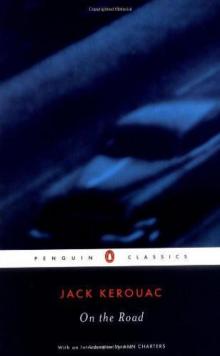 On the Road
On the Road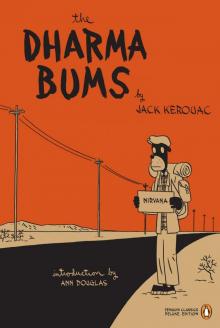 The Dharma Bums
The Dharma Bums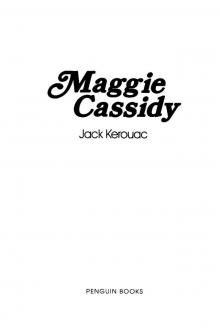 Maggie Cassidy
Maggie Cassidy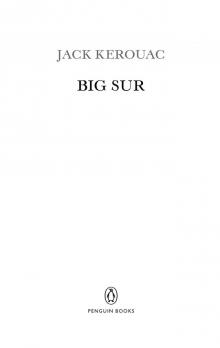 Big Sur
Big Sur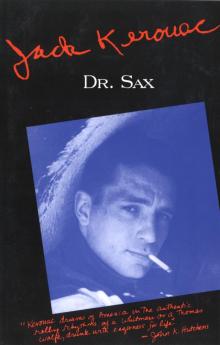 Dr. Sax
Dr. Sax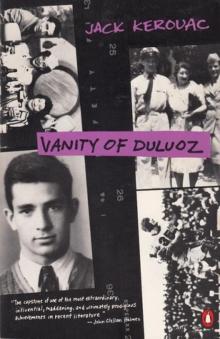 Vanity of Duluoz: An Adventurous Education, 1935-46
Vanity of Duluoz: An Adventurous Education, 1935-46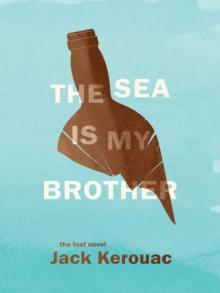 The Sea Is My Brother
The Sea Is My Brother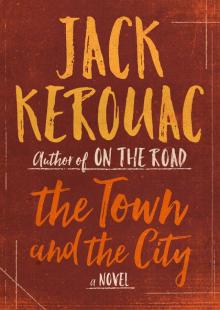 The Town and the City: A Novel
The Town and the City: A Novel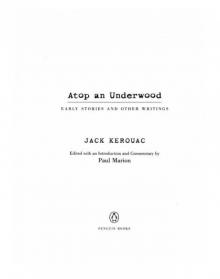 Atop an Underwood: Early Stories and Other Writings
Atop an Underwood: Early Stories and Other Writings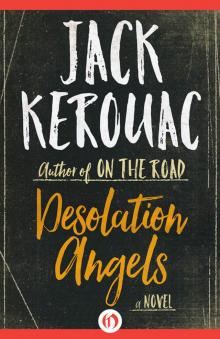 Desolation Angels: A Novel
Desolation Angels: A Novel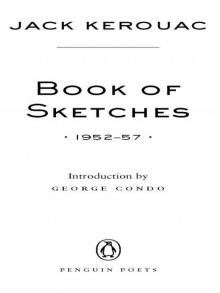 Book of Sketches
Book of Sketches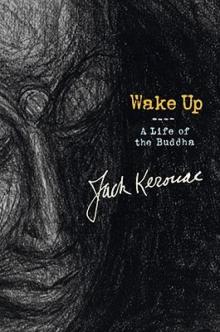 Wake Up: A Life of the Buddha
Wake Up: A Life of the Buddha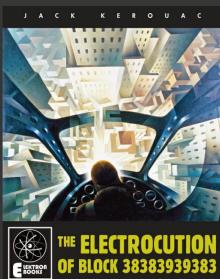 The Electrocution of Block 38383939383
The Electrocution of Block 38383939383 Haunted Life
Haunted Life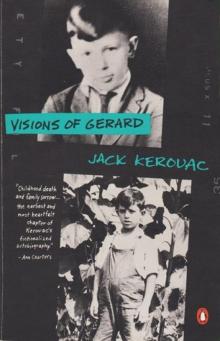 Visions of Gerard
Visions of Gerard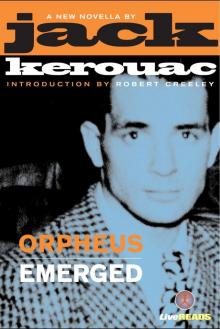 Orpheus Emerged
Orpheus Emerged Book of Blues
Book of Blues The Subterraneans
The Subterraneans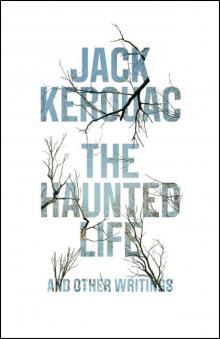 The Haunted Life
The Haunted Life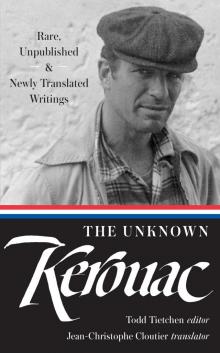 The Unknown Kerouac
The Unknown Kerouac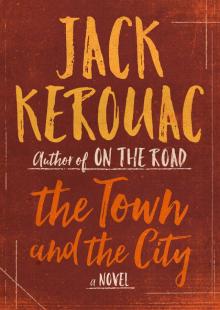 The Town and the City
The Town and the City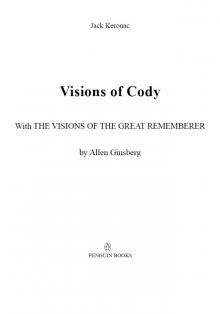 Visions of Cody
Visions of Cody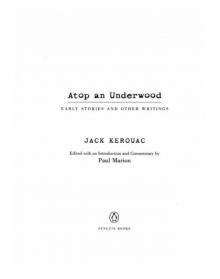 Atop an Underwood
Atop an Underwood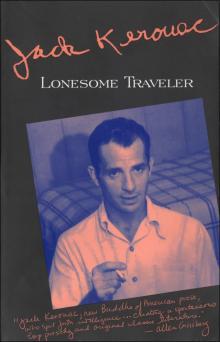 Lonesome Traveler
Lonesome Traveler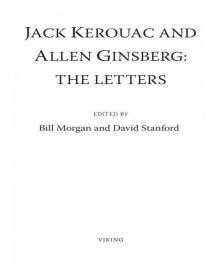 Jack Kerouac and Allen Ginsberg
Jack Kerouac and Allen Ginsberg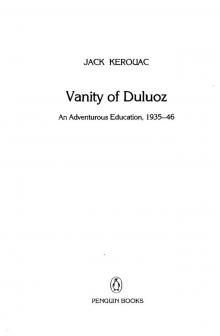 Vanity of Duluoz
Vanity of Duluoz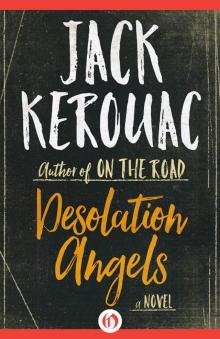 Desolation Angels
Desolation Angels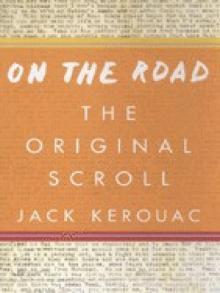 On the Road: The Original Scroll: (Penguin Classics Deluxe Edition)
On the Road: The Original Scroll: (Penguin Classics Deluxe Edition)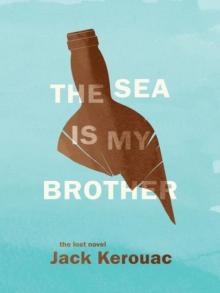 The Sea Is My Brother: The Lost Novel
The Sea Is My Brother: The Lost Novel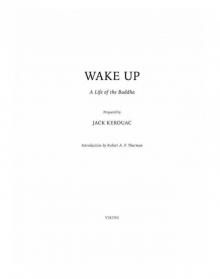 Wake Up
Wake Up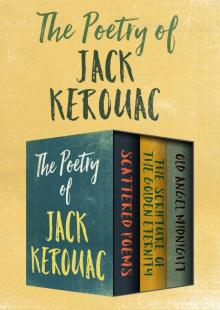 The Poetry of Jack Kerouac
The Poetry of Jack Kerouac Doctor Sax
Doctor Sax